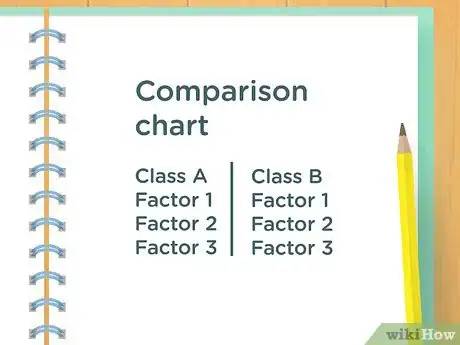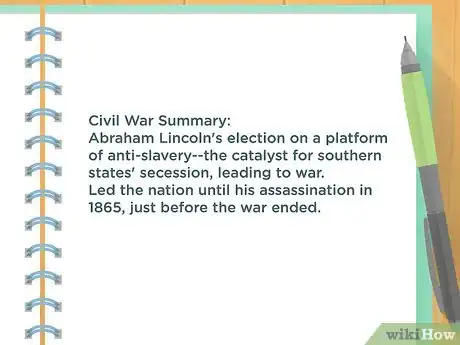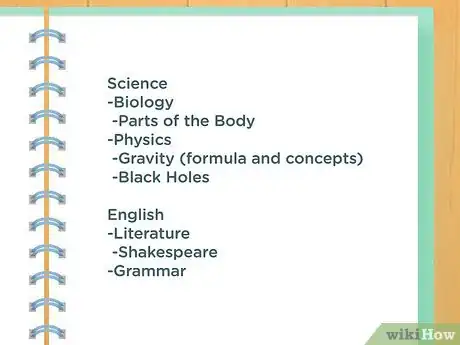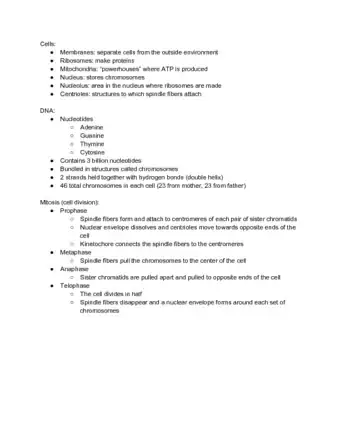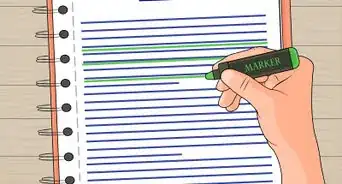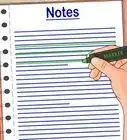This article was co-authored by Jake Adams. Jake Adams is an academic tutor and the owner of Simplifi EDU, a Santa Monica, California based online tutoring business offering learning resources and online tutors for academic subjects K-College, SAT & ACT prep, and college admissions applications. With over 14 years of professional tutoring experience, Jake is dedicated to providing his clients the very best online tutoring experience and access to a network of excellent undergraduate and graduate-level tutors from top colleges all over the nation. Jake holds a BS in International Business and Marketing from Pepperdine University.
There are 9 references cited in this article, which can be found at the bottom of the page.
This article has been viewed 207,135 times.
Study guides can provide you with a quick and easy way to go over important material before tests or exams. There are a number of different basic study guide formats and each is designed to help you consolidate information in a way that's easy to read and approachable. Different topics can lend themselves to different formats of study guide better than others, but a study guide is only ever as good as the information you put in it. Make sure you are pulling from reliable sources when putting your guide together and focus on organizing the material in a way that makes sense to you.
Steps
Choosing a Format
-
1Make a concept map. Concept maps or branching diagrams are a way of mapping ideas so you can easily follow information from general to specific. Concept maps are best for people who learn visually, allowing you to draw connections between things.[1]
- An example of a concept map would be placing the title of a chapter at the center of the map, with lines going to each main topic addressed within the chapter. Each topic could then have lines going to supporting evidence, providing you with an easy visual map of the content in the chapter.
- These study guides resemble flow charts and involve using broad ideas with branches to subsidiary ideas.
- Concept maps let you arrange your information spatially, in an expanding web, instead of in a linear format like most study guides.
- Start with a main topic in the center, then draw branches from it with each supporting piece of information.
- There are various websites, such as Canva or Lucidchart, that will help you design a concept map online.
-
2Create a comparison chart. Comparison charts are an easy way to organize information you want to compare. This method is most effective if you are trying to establish similarities and differences between facts, theories or subjects.
- Comparison charts let you see relationships between specific characteristics or categories.
- Comparison charts are particularly helpful in science classes where you may be trying to identify relationships between organisms.
- A good use for a comparison chart may be identifying the similarities and differences between the American and French revolutions or something with both coinciding and differing elements.
- Create a table with the topics listed in a column followed by columns for various pieces of information that relates or differs from each.
Advertisement -
3Write out concept cards. Concept cards are well organized flash cards. They should usually be made on index cards that are three inches by five inches or larger. Concept cards are great for helping you memorize material and quiz yourself on subjects like math, science or history.[2]
- Write the key idea or concept on the front of the card along with the category (if there is one) and the source you used to gain the information.
- Write the most important content pertaining to the idea or concept on the back of the card. Consider what you might be tested on when you make these cards.
- Summarize information to make it easy to go over as you study.
-
4Make a summary sheet. The easiest and most common form of study guide is the summary sheet. Simply start by summarizing important parts of your notes. Summary sheets are excellent for people will learn well by reading over material. They are particularly useful for history and literature classes with little memorization required.
- Use titles for sections that are meaningful to you to help you understand the concepts.
- If you choose to be detailed and extensive in your summary, this can be one of the most thorough forms of study guide and is great to cover large amounts of material. However, be careful of adding unnecessary information.
- Organize your information chronologically to help you follow the proper steps or progression of your subject.
Preparing Your Study Guide
-
1Gather all of the sources you will need. You will be putting together information from a number of sources, so start by getting them together. The better prepared you are when you begin, the easier the study guide will be to write.[3]
- It will be much easier to assemble your study guide once you have all the sources you will need within arm’s reach.
- All of your assignments and class materials can be valuable when putting together a study guide.
- If the test will be cumulative or quiz you on things you've been tested on before, gather your previous tests to look for areas you may have struggled with.
-
2Use your textbook as a source. Most classes are accompanied by one or more textbooks that are invaluable resources when creating a study guide. Textbooks can help you clarify subjects, organize materials and find definitions of important terms.
- Go back through the sections you covered in class or for assignments and look for important concepts.
- Make a note of bold or italicized words as they may be important to the subject or cover information you may need to know for your exam.
-
3Pull from your notes. Taking good notes in class can help you to retain the information covered, but they can also serve as important parts of your study guide. Your notes can serve to aid in your organization of material as well as to know what areas your teacher thinks are most important.[4]
- Go back through your notes and highlight or underline information that seems important.
- Focus on big concepts or parts that you think are especially important based on the lectures and ensure that information makes it into the study guide.
- Identify areas that you may not be sure about through your notes. Research things you are uncertain of in your textbook and make sure to include that content in your study guide.
- Class handouts are also valuable sources as they show what the instructor felt was important.
-
4Use your homework to guide you. Homework assignments can show you what your teacher felt was important as well as providing an idea for what type of questions may appear on the exam.
- Pay close attention to things you got wrong on the homework. Begin by including those portions in your study guide.
- Homework can also serve as a reminder of all the material you covered over a long semester. Use it to help structure your guide.
-
5Use your previous tests to guide you. The tests you have taken thus far in the semester were designed to test your understanding of the material, so they can be great review tools.
- Topics covered on previous tests will probably be covered again in a final exam.
- Even if the new test has nothing to do with the old one, they can serve to show you what types of questions your teacher will ask and how they expect them to be answered.
Organizing Your Study Guide
-
1Split your information into subjects. Now that you have all the material you will need to assemble your study guide, it’s time to organize it. Organize your study guide in a way that makes sense to you and is easy to follow.[5]
- If you are being tested on a portion of a textbook, you may want to divide your material into what chapter it appears in the book. For instance, organize your study guide by chapter with supporting information, or large concepts such as nations for world history or regions of the body for anatomy.
- Once you have identified what broad topics the information must fall into, use that to begin the framework of your study guide.
- As you fill out portions of the study guide and identify areas you are less certain about, focus on those areas in your research.
-
2Try these examples to help you organize your study guide. Dividing information into easy to follow segments is important to make your study guide useful. Here are examples of dividing information from various subjects into segments that may be more manageable.
- The American Revolution can be divided into time periods on a summary sheet such as “the 1750s, 1760s and 1770-81” or by events such as the Sugar and Stamp Acts, the Boston Tea Party and the Declaration of Independence, followed by supporting information for each category.[6]
- The Periodic Tables can be divided into flash cards to help you memorize the abbreviation for each element.[7]
- Academic psychological approaches can be divided into a concept map. Start with a center circle called “psychological approaches” with branches coming from it for the dynamic approach, humanistic approach and social learnings.[8]
- Viruses or other biological concepts can easily be organized into a comparison chart. If you are using viruses, list them on the left hand column, then create columns for aspects of a virus such as means of transmission, symptoms and treatments.
-
3Don’t jam too much information into your study guide. Your study guide is supposed to help you understand complicated subjects, so keep it easy to understand and follow and don’t be afraid to leave out things that don’t matter.[9]
- Be very picky about what information you include in your study guide to avoid making it too daunting to use.
- You don’t need to cover topics you are extremely comfortable with in as much depth. Instead focus on areas you are unsure of.
- Regardless of what format you use, combine information from each source into single sections regarding each topic. For instance, if your test is on the American Revolution, include everything pertinent from your notes, textbook, homework and tests about Alexander Hamilton into one section of the study guide.
-
4Keep your study guide’s visual presentation simple. You want to be able to reference your study guide easily and frequently, so make it as easy to read and follow as possible. Use spacing, underlining and highlighting to differentiate between topics and make it easy to find what you need.
- Use neat, clear handwriting to ensure you can read everything you put in the study guide.
- Choose the right type of study guide for the material so it’s easy to find the information you’re looking for.
- Be uniform in the way you divide or separate sections so you can easily identify when one topic is complete and you’ve begun on the next.
Sample Study Guides
Community Q&A
-
QuestionHow would I make a study guide for a test based on what I have studied over a whole year?
 Community AnswerYou can write down all the things you have learned on sheets of paper in the same order you learned them. This will help you remember things that you have learned from before quickly.
Community AnswerYou can write down all the things you have learned on sheets of paper in the same order you learned them. This will help you remember things that you have learned from before quickly. -
QuestionHow to get full marks for board exams/public exams?
 Community AnswerPrepare yourself first. Just take one subject at a time. Stay full concentrated. Choose a study space where there is no distractions like phone, t.v, tablet, etc. and study properly.
Community AnswerPrepare yourself first. Just take one subject at a time. Stay full concentrated. Choose a study space where there is no distractions like phone, t.v, tablet, etc. and study properly. -
QuestionHow do I make a study guide for something I learned in a week?
 Community AnswerBalance your work out equally. Use repetition to memorize what you have learned. You can then follow the steps in this article.
Community AnswerBalance your work out equally. Use repetition to memorize what you have learned. You can then follow the steps in this article.
References
- ↑ https://learningcenter.unc.edu/tips-and-tools/using-concept-maps/
- ↑ https://learning.ucmerced.edu/sites/learning.ucmerced.edu/files/page/documents/conceptcards.pdf
- ↑ https://learningcenter.unc.edu/tips-and-tools/studying-101-study-smarter-not-harder/
- ↑ https://learningcenter.unc.edu/tips-and-tools/effective-note-taking-in-class/
- ↑ https://www.herzing.edu/blog/how-create-successful-study-guide
- ↑ http://www.sparknotes.com/history/american/revolution/
- ↑ http://stemsheets.com/science/periodic-table-flash-cards
- ↑ http://success.oregonstate.edu/sites/success.oregonstate.edu/files/LearningCorner/Tools/creating_study_guides.pdf
- ↑ https://www.herzing.edu/blog/how-create-successful-study-guide
- ↑ Jake Adams. Academic Tutor & Test Prep Specialist. Expert Interview. 20 May 2020.

